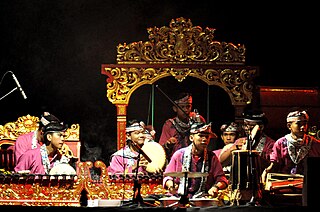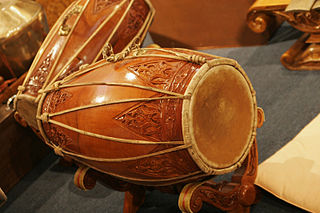
Gamelan is the traditional ensemble music of the Javanese, Sundanese, and Balinese peoples of Indonesia, made up predominantly of percussive instruments. The most common instruments used are metallophones played by mallets and a set of hand-played drums called kendhang, which register the beat. The kemanak and gangsa are commonly used gamelan instruments in Java. Other instruments include xylophones, bamboo flutes, a bowed instrument called a rebab, siter, and vocalists named sindhen (Female) or gerong (Male).

Pelog is one of the essential tuning systems used in gamelan instruments that has heptatonic scale. The other, older, scale commonly used is called slendro. Pelog has seven notes, but many gamelan ensembles only have keys for five of the pitches. Even in ensembles that have all seven notes, many pieces only use a subset of five notes.

Gamelan gong kebyar is a style or genre of Balinese gamelan music of Indonesia. Kebyar means "to flare up or burst open", and refers to the explosive changes in tempo and dynamics characteristic of the style. It is the most popular form of gamelan in Bali, and its best known musical export.

Gamelan surakarta A typical large, double gamelan in contemporary solo (Surakarta) will include, in the sléndro set, one saron panerus, two saron barung, one or two saron demung, one gendér panerus, one gender barung, one slenthem, one bonang panerus and one bonang barung, one gambang kayu, one siter or celempung, one rebab, one suling, one pair of kethuk and kempyang, one set of three to five kenong, one set of three to five kempul, one to three gong suwukan, and one gong ageng.

Kotekan is a style of playing fast interlocking parts in most varieties of Balinese Gamelan music, including Gamelan gong kebyar, Gamelan angklung, Gamelan jegog and others.

A clap is the percussive sound made by striking together two flat surfaces, as in the body parts of humans or animals. Humans clap with the palms of their hands, often quickly and repeatedly to express appreciation or approval, but also in rhythm as a form of body percussion to match the sounds in music, dance, chants, hand games, and clapping games.

A gendèr is a type of metallophone used in Balinese and Javanese gamelan music. It consists of 10 to 14 tuned metal bars suspended over a tuned resonator of bamboo or metal, which are tapped with a mallet made of wooden disks (Bali) or a padded wooden disk (Java). Each key is a note of a different pitch, often extending a little more than two octaves. There are five notes per octave, so in the seven-note pélog scale, some pitches are left out according to the pathet. Most gamelans include three gendèr, one for sléndro, one for pelog pathet nem and lima, and one for pelog pathet barang.

Gamelan beleganjur is one of the most popular styles of gamelan music in Bali. Its closest Western analogue is probably the Western military band.

The babandil is a single, narrow-rimmed Philippine gong used primarily as the “timekeeper” of the Maguindanao kulintang ensemble.

The saron is a musical instrument of Indonesia, which is used in the gamelan. It normally has seven bronze bars placed on top of a resonating frame (rancak). It is usually about 20 cm (8 in) high, and is played on the floor by a seated performer. In a pelog scale, the bars often read 1-2-3-5-6-7 across ; for slendro, the bars are 6-1-2-3-5-6-1; this can vary from gamelan to gamelan, or even among instruments in the same gamelan. Slendro instruments commonly have only six keys. It provides the core melody (balungan) in the gamelan orchestra.

The gong ageng is an Indonesian musical instrument used in the Javanese gamelan. It is the largest of the bronze gongs in the Javanese and Balinese gamelan orchestra and the only large gong that is called gong in Javanese. Unlike the more famous Chinese or Turkish tam-tams, Indonesian gongs have fixed, focused pitch, and are dissimilar to the familiar crash cymbal sound. It is circular, with a conical, tapering base of diameter smaller than gong face, with a protruding polished boss where it is struck by a padded mallet. Gongs with diameter as large as 135 centimeters have been created in the past, but gongs larger than about 80 centimeters are more common especially to suit the budget of educational institutions.

Kendang or Gendang is a two-headed drum used by people from the Indonesian Archipelago. Kendang is one of the primary instruments used in the Gamelan ensembles of Javanese, Sundanese, and Balinese, the Kendang ensemble as well as various Kulintang ensembles in Indonesia, Brunei, Malaysia, Singapore, and the Philippines. It is constructed in a variety of ways by different ethnic groups. It is a relation to the Indian mridangam double-headed drum.

The bonang is an Indonesian musical instrument used in the Javanese gamelan. It is a collection of small gongs placed horizontally onto strings in a wooden frame (rancak), either one or two rows wide. All of the kettles have a central boss, but around it the lower-pitched ones have a flattened head, while the higher ones have an arched one. Each is tuned to a specific pitch in the appropriate scale; thus there are different bonang for pelog and slendro. They are typically hit with padded sticks (tabuh). This is similar to the other cradled gongs in the gamelan, the kethuk, kempyang, and kenong. Bonang may be made of forged bronze, welded and cold-hammered iron, or a combination of metals. In addition to the gong-shaped form of kettles, economical bonang made of hammered iron or brass plates with raised bosses are often found in village gamelan, in Suriname-style gamelan, and in some American gamelan. In central Javanese gamelan there are three types of bonang used:

Colotomy is an Indonesian description of the rhythmic and metric patterns of gamelan music. It refers to the use of specific instruments to mark off nested time intervals, or the process of dividing rhythmic time into such nested cycles. In the gamelan, this is usually done by gongs of various size: the kempyang, ketuk, kempul, kenong, gong suwukan, and gong ageng. The fast-playing instruments, kempyang and ketuk, keep a regular beat. The larger gongs group together these hits into larger groupings, playing once per each grouping. The largest gong, the gong ageng, represents the largest time cycle and generally indicates that that section will be repeated, or the piece will move on to a new section.

Gerong is the Javanese verb meaning "to sing in a chorus." Penggerong is the proper name of a member of the chorus, but often the word gerong is used to refer to the unison male chorus that sings with the gamelan. The chorus or the melody may also be called the gerongan.
The sèlèh note or nada seleh is an Indonesian music concept used in Javanese gamelan music. In Javanese gamelan music, the sèlèh note or nada seleh is the final note of a gatra, or four-beat melodic unit. As such it is the note which serves as the goal for all the various strands of the musical texture.

The panerusan instruments or elaborating instruments are one of the divisions of instruments used in Indonesian gamelan. Instead of the rhythmic structure provided by the colotomic instruments, and the core melody of the balungan instruments, the panerusan instruments play variations on the balungan. They are usually the most difficult instruments to learn in the gamelan, but provide the most opportunity for improvisation and creativity in the performer.
Imbal or imbalan is a technique used in Indonesian Javanese gamelan. It refers to a rapid alternation of a melodic line between instruments, in a way similar to hocket in medieval music or kotekan in Balinese gamelan. "A style of playing in which two identical or similar instruments play interlocking parts forming a single repetitive melodic pattern."
This imbal is a method of playing in which the nuclear theme is played by one of the nyaga's 'broken up' into half-values, what time another player beats alternately with the first, but in such a way that his tones, each of which comes between two of his colleague's, are always one step lower than the nuclear theme tone immediately preceding it. From practical considerations this imbal is, if possible, divided over two demungs; if only one such instrument is available, the two players sit facing each other. The player who beats the nuclear theme tones is said to play the gawé (...); the other one, the nginţil (...).
A gatra is a unit of melody in Indonesian Javanese gamelan music, analogous to a measure in Western music. It is often considered the smallest unit of a gamelan composition.

Kroncong is the name of a ukulele-like instrument and an Indonesian musical style that typically makes use of the kroncong. A kroncong orchestra or ensemble traditionally consists of a flute, a violin, at least one, but usually a pair of kroncongs, a cello in pizzicato style, string bass in pizzicato style, and a vocalist. Kroncong originated as an adaptation of a Portuguese musical tradition, brought by sailors to Indonesian port cities in the 16th century. By the late 19th century, kroncong reached popular music status throughout the Indonesian archipelago.


















